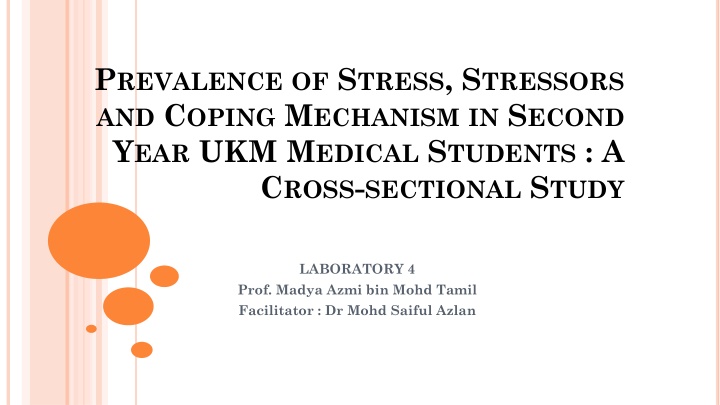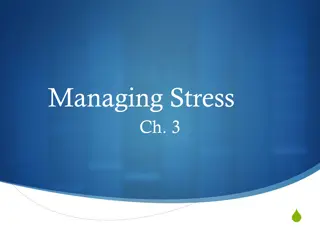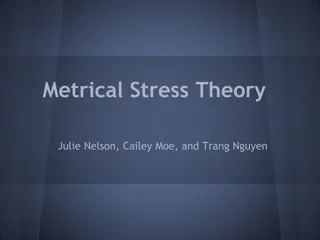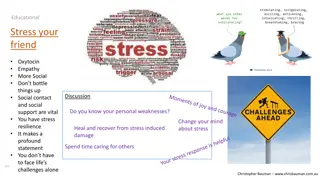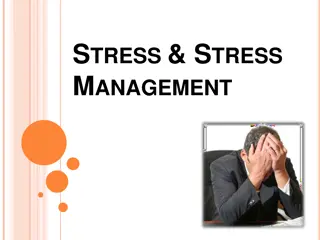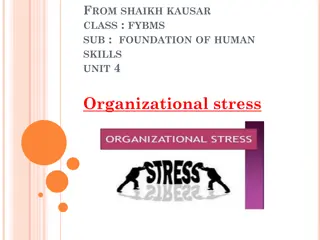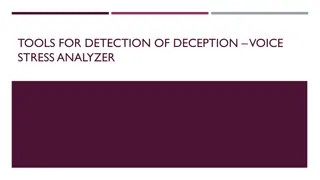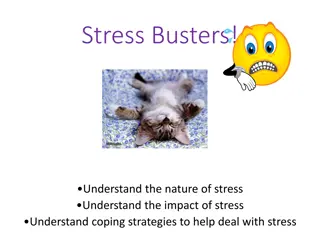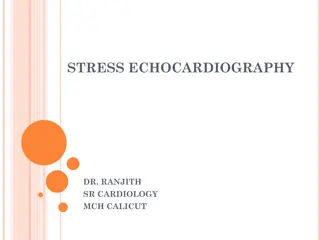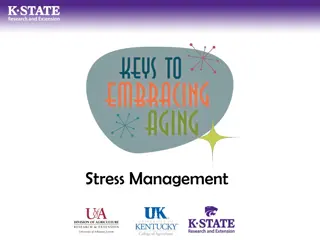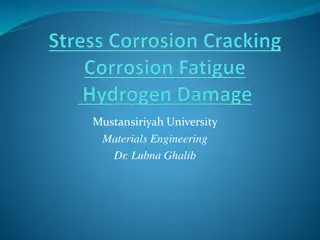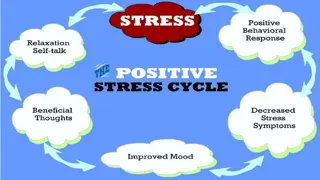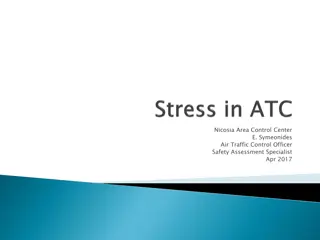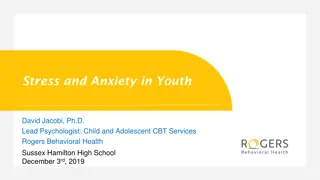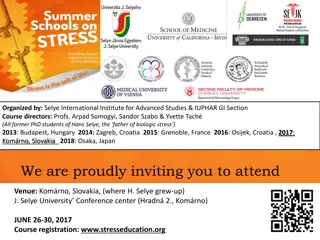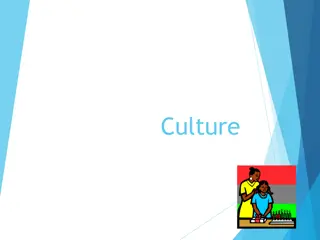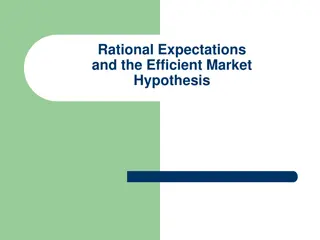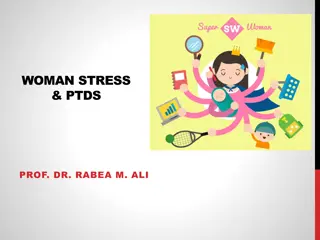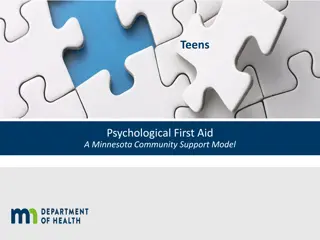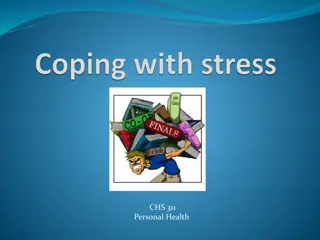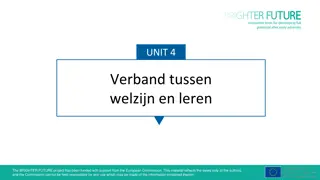Stress and Cultural Expectations
Stress is a universal experience, impacting individuals across different cultures and economic classes. This content explores the psychological, societal, and economic aspects of stress, highlighting the pressures faced by individuals, especially children in Eastern China. It delves into the impact of stress on various facets of life, emphasizing the need for adaptive coping mechanisms. Additionally, it sheds light on cultural expectations and the influence of socioeconomic factors on stress levels.
Download Presentation

Please find below an Image/Link to download the presentation.
The content on the website is provided AS IS for your information and personal use only. It may not be sold, licensed, or shared on other websites without obtaining consent from the author.If you encounter any issues during the download, it is possible that the publisher has removed the file from their server.
You are allowed to download the files provided on this website for personal or commercial use, subject to the condition that they are used lawfully. All files are the property of their respective owners.
The content on the website is provided AS IS for your information and personal use only. It may not be sold, licensed, or shared on other websites without obtaining consent from the author.
E N D
Presentation Transcript
PREVALENCE OF STRESS, STRESSORS AND COPING MECHANISM IN SECOND YEAR UKM MEDICAL STUDENTS : A CROSS-SECTIONAL STUDY LABORATORY 4 Prof. Madya Azmi bin Mohd Tamil Facilitator : Dr Mohd Saiful Azlan
LAB 4 1. SINARAN SAMSURI 2. SITI NUR WARDAH BINTI ISHAK 3. MUHAMMAD SYAHIR AFHAM BIN KAMARUDDIN 4. MUHAMAD NAIM BIN ZULKIFLE 5. MUHAMMAD HAZIQ BIN ABDUL SUKI 6. SHAH ABAS MUHAMAD BIN MD SHAH 7. WONG JENG YUAN 8. CHAN ZI NIAN 9. NUR ALYANIE BINTI ABDUL MAJI 10.CHAI KAR YEE 11.NORDIANA IZIANY BINTI NORDIN 12.LOUSHINNAH D/O MOHAN 13.SITI MARYAM BINTI KAMARUDIN 14.NUR NADWIN YUSHAHIRA BINTI MOHD YUSOFF 15.NURUL AYUNI SYAFIQAH BINTI MAT ROPI 16.NURUL FARZANA BINTI BIDIN 17.LEE PEI CHIEH 18.KRIMIYA BINTI YUSOF GA02540 A143628 A143655 GA02523 A148987 A147319 A149598 A148513 A149741 A149669 A149100 GA02520 A147310 A148230 A147946 A149505 A149049 A143704
INTRODUCTION What is stress? a situation where demands on a person exceed that person s resources or ability to cope . (Stress Management Society) the reaction people may have when presented with demands and pressures that are not matched to their knowledge and abilities and which challenge their ability to cope Justification Students are subjected to different kinds of stressors, such as the pressure of academics with an obligation to succeed, an uncertain future and difficulties of integrating into the system. (WH0, 2003) (Fish & Nies, 1996 ) Information on sources and severity of stress and coping strategies are lacking among medical students in medical schools . (Sarina MY, 2011)
GENERAL OBJECTIVE To determine the level of stress and stressors among second year medical student and to identify the stress coping mechanisms used by second year medical students of Faculty of Medicine, UKM.
SPECIFIC OBJECTIVES To determine the level of stress among second year medical students of Faculty of Medicine, UKM. To determine whether gender has effect on the stress level among students. To determine the stressors among students. To determine the most commonly used coping mechanisms among students.
HYPOTHESIS Medical students are generally stressed. Female students have a higher stress level compared to male students. Stressors associated with the stress status among students include academic-related stressors, interpersonal-related stressors, and group activities-related stressors. The most common cope used by students is through religious approach.
LITERATURE REVIEW Prevalence of stress 41.9% of the medical students were found to have psychological stress which was significantly association with depression The prevalence of psychological stress was only slightly higher among the females compared to the males. (Sherina Mohd. Sidik,2003) SOURCE : PSYCHOLOGICAL STRESS AMONG UNDERGRADUATE MEDICAL STUDENTSBYM S SHERINA, MMED, L RAMPAL, PHD, N KANESON, BSC DEPARTMENTOF COMMUNITY HEALTH, FACULTYOF MEDICINEAND HEALTH SCIENCES, UNIVERSITI PUTRA MALAYSIA, SELANGOR, MALAYSIA.
LITERATURE REVIEW STRESSOR (GARS) Group related activity was found to be the main factor affecting psychological distress in preclinical medical students in Universiti Putra Malaysia in 2014. (Prof. Dato Dr. Lye Munn Sann, 2014) Source : Prevalence and risk factors of Stress, Anxiety and Depression among Preclinical Medical students in Universiti Putra Malaysia in 2014 by Maher D. Fuad Fuad, Munn Sann Lye *, Normala Ibrahim, Siti Irma Fadhillah binti Ismail, Phang Cheng Kar, Faculty of Health and life sciences, Universiti Putra Malaysia, Selangor, Malaysia.
STRESSOR (ARS) The major stressors were related to academic and contributing factors of stress were related to university, coping strategies, types of stressors and parents income status ( Muhamad Saiful Bahri Yusoff, 2011) SOURCE : A STUDYONSTRESS, STRESSORSANDCOPINGSTRATEGIES AMONG MALAYSIANMEDICALSTUDENTSBY MUHAMAD SAIFUL BAHRI YUSOFF, LIEW YEN YEE, LING HENG WEI, TAN CHIN SIONG, LOKE HON MENG, LIM XUE BIN, AHMAD FUAD ABDUL RAHIM , UNIVERSITI SAINS MALAYSIA, KELANTAN, MALAYSIA.
STRESSOR (IRS) Year of study, financial problem and relationship problem with parents, siblings and lecturers were the significant determinants of stress among medical students (Rabeya Yousuf,2013) SOURCE : STRESSAMONG MEDICAL STUDENTSIN MALAYSIABY ABDUS SALAM, RABEYA YOUSUF, SHEIKH MUHAMMAD ABU BAKAR AND MAINUL HAQUE, MALAYSIAN PUBLIC UNIVERSITIES.
LITERATURE REVIEW Coping mechanism The findings revealed that the five commonest adopted coping strategies by Malaysian medical students were religion, active coping, positive reframing, acceptance and planning. (MSB Yusoff, 2011) Source : Stress, Stressors and Coping Strategies among Malaysian Medical Students by Muhamad Saiful Bahri Yusoff, Liew Yen Yee, Ling Heng Wei, Tan Chin Siong, Loke Hon Meng, Lim Xue Bin, Ahmad Fuad Abdul Rahim. Published on 2011.
PROBLEM FRAMEWORK GARS ARS COPING MECHANISM STRESS STRESSORS IRS
METHODOLOGY Research design: - cross-sectional study design Study field: -PPUKM Cheras Study population: - 100 second year student in medical faculty in UKM. Sampling technique: - simple randomization by random generated numbers via Microsoft Excel
Data collection tools: - the questionnaire consist of 3 parts which are PSI(measure level of stress). MSSQ (identify the most common stressor) Brief Cope(coping mechanism) Data analysis -SPSS to analyse the data by descriptive and analytical statistic(bivariate analysis)
Operational Definition STRESS LEVEL (based on PSI) -score less than 36 is considered not stress. -score 36 and above is considered stress. STRESSORS (based on MSSQ) 0= causing no stress at all 1= causing mid stress 2= causing moderate stress 3= causing high stress 4= causing severe stress COPING MECHANISM (based on BRIEF COPE) 1 = I haven't been doing this at all 2 = I've been doing this a little bit 3 = I've been doing this a medium amount 4 = I've been doing this a lot
ANALYTICALANALYSIS Level of significance: 5%
Gender and stress level - Pearson Chi- Square
Gender and Stress status - Chi-square test
Stress Level PSI Score Stress Not Stress Mean Standard deviation 17.23 Male 11 (50.0%) 26 (36.6%) 11 (50.0%) 45 (63.4%) 36.45 Female 35.53 21.71 From the table, 50.0% of the male students is stressed while 36.6% of the female is stressed. The mean PSI score (indicator for stress level) of male is 36.45 17.23 which is higher than female 35.53 21.71.
H0: THEREISNOASSOCIATIONBETWEENGENDERANDSTRESSLEVEL Associating Factor Square Gender 1.255 Even though larger proportion of male is stressed with higher mean PSI score, the difference is insignificant with p>0.05. Pearson Chi- Degree of freedom 1 P-value 0.263 H0 is not rejected. There is no association between gender and stress Status
Stressor and stress status - T-test
H0: THEREISNOSIGNIFICANTDIFFERENCEOFSCOREOFSTRESSORS BETWEENSTRESSANDNON-STRESSMEDICALSTUDENTS. MSSQ Stress Status T-test P-value Stress Mean (SD) 2.63 (0.64) Not stress Mean (SD) 2.29 (0.68) Academic Related Stressors (ARS) 2.46 0.016 (significant) Interpersonal Related Stressors (IRS) 1.93 (1.14) 1.53 (1.01) 1.80 0.076 (not significant) Group Activities Related Stressors (GARS) From the table, the mean MSSQ score for all 3 categories are higher in stressed students. The highest mean score falls to ARS, thus ARS is believed to be the commonest stressor among stressed medical students. 2.26 (1.00) 1.76 (0.93) 2.50 0.014 (significant) Based on the T-test, the results for ARS and GARS are significant (p< 0.05). H0 is rejected. ARS and GARS have significant contribution to the stress status among medical students.
Coping strategies - correlation to stress status
Coping Strategies Stress Mean (SD) Coping Strategies Not Stress Mean (SD) religion planning self-distraction instrumental support active coping Based on the table : 1. The five most commonly used coping strategies among stressed students are religion (3.54), planning (3.17) , self-distraction (3.08), instrumental support (3.07) and active coping (3.00). 3.54 (0.98) 3.17 (0.74) 3.08 (0.74) 3.07 (0.86) religion positive reframing planning acceptance 3.20 (0.79) 3.03 (0.82) 2.99 (0.75) 2.95 (0.79) 3.00 (0.77) self-distraction 2.87 (0.81) 2. The five most common coping strategies used by not stressed students are religion (3.20), positive reframing (3.03), planning (2.99), acceptance (2.95) and self-distraction (2.87). 3. Religion is the most common coping strategies among stressed and not stressed students. It also shows negative correlation with stress level.
Coping Strategies Religion Active coping Self distraction Planning Instrumental support Correlation -0.12 -0.065 -0.042 -0.039 -0.030 Statistical value 0.071 0.434 0.561 0.702 0.728 The table shows some of the common coping strategies used among stressed and not stressed medical students. All of the coping strategies show negative correlation with stress level. This suggests that with the use of these coping strategies, the stress level can be reduced.
CONCLUSION There is no association between gender and stress status ARS and GARS have significant contribution to the stress status among medical students Religion is the most common coping strategies among stressed and not stressed students.
LIMITATIONS OF THE STUDY 1) Sample size -Research were only doing for a 100 medical students which is small in number from all UKM medical students . -Cannot represent a true picture of the all medical students. 2) Questionnaire -The students response in questionnaire may not accurate or the students misunderstood the questions. - Students may also feel uninterested in answering the questionnaire thus giving wrong answers. 3) Timing -the questionnaire was distributed after the students finished sitting for their EOM -the answers provided by the students may not represent the real stress situation.
SUGGESTIONS FOR FUTURE RESEARCH We should conduct the study among the students in variety fields. Increase the sample size that represent the general population. We should conduct our research before and after exam to get more accurate results.
REFERENCES 1. Psychological Stress Among Undergraduate Medical Students by M S Sherina, MMed, L Rampal, PhD, N Kaneson, BSc Department of Community Health, Faculty of Medicine and Health Sciences, Universiti Putra Malaysia, Selangor, Malaysia. 2. Prevalence and risk factors of Stress, Anxiety and Depression among Preclinical Medical students in Universiti Putra Malaysia by Maher D. Fuad Fuad, Munn Sann Lye *, Normala Ibrahim, Siti Irma Fadhillah binti Ismail, Phang Cheng Kar, Faculty of Health and Life Sciences, Universiti Putra Malaysia, Selangor, Malaysia, 2014 3. Stress, stressors and coping strategies among Malaysian medical students by Muhamad Saiful Bahri Yusoff, Liew Yen Yee, Ling Heng Wei, Tan Chin Siong, Loke Hon Meng, Lim Xue Bin, Ahmad Fuad Abdul Rahim , Universiti Sains Malaysia, Kelantan, Malaysia, 2011. 4. Stress among Medical Students in Malaysia by Abdus Salam, Rabeya Yousuf, Sheikh Muhammad Abu Bakar and Mainul Haque, Malaysian Public Universities 5. Psychological Well-being, Stress and Coping Style among UiTM Preclinical Medical student byAzlina Wati Nikmat, Mariam Mohamad, Anisah Omar and Salmi Razali from Research Management Institute, Universiti Teknologi Mara (UiTM), September 2010.
